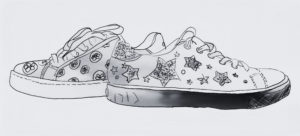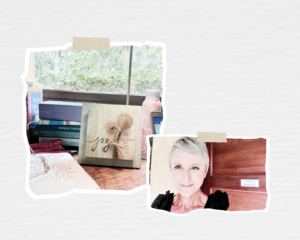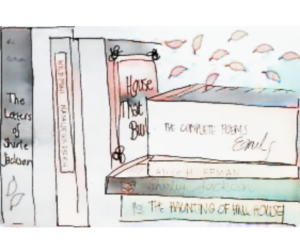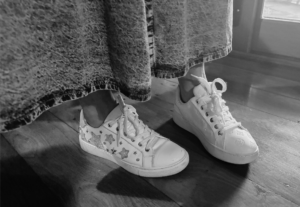
Today she chose to wear odd shoes.
The left white with embossed flowers, the right spangled with stars,
In the mismatch of this truth there was nothing to lose.
A social experiment not yet abandoned at the feet of dreams in recluse.
What a life awaited in the toes of boots painted red!
Could the same be found in her choice to wear odd shoes?
Thank you but no, the demand to set a new pair on the kitchen table she must refuse.
“I don’t care!”, she shouted, “I have done the left and right thing instead!”
In the mismatch of this truth there was nothing to lose.
She stepped outside a woman on the edge of rhythm and blues,
And saw others like her with feet bound, stripped bare and weighed down with lead.
In memoriam, she set a candle alight and chose to wear odd shoes.
She then sewed herself a pretty strapless dress and tossed them a ruse
“Quite mad!” they all said, “and definitely not quite right in the head!”
In the mismatch of this truth there was nothing to lose.
Oh, the shoes, the shoes, and don’t forget the shoes!
Without her lovely lopsidedness she might well be dead.
Today she placed her feet inside and chose to wear odd shoes.
In the mismatch of this truth there was nothing to lose.
“The shoes became so much a part of me that I forgot I was wearing them. I let my mind wander.”[1]Susan Griffin, (1995), “The red shoes”, in The Eros of Everyday Life : Essays on Ecology, Gender and Society, Open Road Integrated Media, Inc., p. 204.

Susan Griffin (1943- )
Radical feminist philosopher, essayist and playwright
I wasn’t wearing any shoes when I wrote this villanelle or a pretty strapless dress. Wearing shoes just did not fit the context I was in—a four day writing retreat at Ditipur in Nashua, northern NSW—and so I didn’t. I didn’t intend to write poetry about shoes; it was a writing project I stepped into out of necessity—in the fickleness of summer rain out of town, the internet at Ditipur has gone down and decided to stay there in the damp. Skin on skin back to basics was the only way I was going to be able to write and this is how it happened.
Writing begins in the Emily Dickinson room
Located approximately 4km out of Bangalow in the shire of Byron Bay, Ditipur is a beautiful Balinese inspired homestead tucked away in the rainforest hinterland. Deep tropical leaves of green frames dark wooden architecture and there is space to breathe—a yoga studio, an octagonal meditation room, an art workroom, and a perfectly splendid round swimming pool. Each room bares a small brass plaque with the name of a well-known author on the door—William Yeats, Mary Oliver, Arundhati Roy, Henry David Thoreau, Maya Angelou, and to my delight, Emily Dickinson.

Entering her room, I am greeted by a white floral cover on the double bed, sheer white curtains on the window, and cool earthen tiles under my bare feet. There is a quaint nook of books nestled in the study area and my heart quickens ever so lightly as I peruse the contents—a copy of Sondra Perl and Mimi Schwartz’s writing guide Writing True: The Art and Craft of Creative Non-Fiction juts out and makes itself known. I was recently introduced to Sondra Perl’s work Felt Sense: Writing with the Body and was moved to promise myself to read her writing more deeply; it feels serendipitous that her words present themselves in this moment. The opening sentence of the preface offers, “creative nonfiction is a new name for an old impulse: to write about the real world with grace, power and personal commitment”; and I gratefully accept the gift. While there are none of her books on the shelf in the Emily room, I have my own copy of The Complete Poems with me (as is my habit) and I carefully place it on the heavy rustic oak desk next to Writing True, Holly Ringland’s The House that Joy Built, Natalie Goldberg’s Wild Mind, and the collection of Shirley Jackson works I have brought as inspiration. With the weight of wood and women’s words underneath and in front of me, I am ready to begin.

The day swirls by as bare-footed words twirl in wild abandon from the lamp in my spine onto the page, released as they now are from the distraction of online searching. [2]According to the Merriam Webster Online dictionary, searching online otherwise known as “googling”, was a term first used in 2000. Twenty years on, the innate hunger for information is … Continue reading I have loved flip-flopping around between skin and slippers, and it is only now as I contemplate going to the local pub for dinner that my thoughts turn to the shoes I have brought to wear. I wore my black Converse with a silver tongue and sparkly laces yesterday, and my worn-out Asics Gel Nimbus running shoes this morning. In my mind, I packed the pristine white pair of Guess sneakers I recently purchased in the post-Christmas sales, versatile enough to dress up or down for work or play, and easily coordinated without too much concern for colour. I reach into the cupboard to retrieve them from my overnight bag, and my breath catches. The shoes I have packed might be casual and white, but the pair does not match—I have brought with me a pair of odd shoes.
I place them side by side wondering if maybe I could just get away with the difference—for a while now I have been wearing mismatched studs in my first ear piercing, always a silver heart in my left and something that mirrors my outfit in the right, and I think to myself this approach could work for my feet too, couldn’t it? After all, it worked for Naomi Harris in 2017, didn’t it?[3]Christine Whitney’s 2017 article in The Cut, “Why you might want to try mismatched shoes” aptly describes this red carpet moment. I know it was the red carpet at the Oscars, I know they were yellow-suede and custom-made, and I know that the placement of crystal embellishments was subtle and made them appear more asymmetrical than mismatched. And what about Punky Brewster’s shoes? Two high top Converse in totally different colours whose wearer marched to her own drum. I take another look at my odd shoes. If style is a way to say who you are without having to speak, my footwear is screaming at me to stay bare foot—the left shoe is new and shiny, and the right old and faded. I sigh deeply, “NEUROAESTHETICS 101”—the human brain is wired for balance for it is there where beauty resides, and here another crucial encounter, broken.[4]In her essay, “Fashion as Art” in the 2020 collection Why Didn’t You Just do What You Were told?, Jenny Diski reflects on style and the ways that particular items of clothing … Continue reading
Oh, the shoes!
I have never done anything like this before. I try not to read too much into it—it could happen to anyone, couldn’t it? The fear that appearing wearing odd shoes is not just a social fashion disaster but the kind of person I am alarms me[5]Jenny Diski expresses a similar distress inWhy Didn’t You Just do What You Were told? (2020, p. 192). She speaks to the innate terror of a psychic split between the way we think we appear … Continue reading and I know that this train of thought can’t be controlled; so, I give in. My wild mind scratches and screams its way out of containment and flings itself into the abyss. I see myself in the mirror carefully applying war paint to make it possible to face the world only to witness the betrayal of mascara running that declares my mask a fakery. Oh, the shoes! I see myself cowering in a dark corner, paralysed by the on-going trauma of marriage to a monster and unable to function normally. Oh, the shoes, the shoes! I see myself splintering under the strain of making sure day in and day out my boys are alright, the shards of worry niggling and needling no matter how tightly I hold them in my arms. I see myself staring lock stock and smoking down the barrel of a future dictated by inherited dementia. Oh, the shoes, the shoes, and don’t forget the shoes! How could I not forget about the shoes when these are the things that I cannot forget? Oh, to flee from memory had I a matching pair of shoes![6]This phrase, like so many others I write, is inspired by Emily Dickinson and her poem “To flee from memory”, The Complete Poems, #1242, p. 546.
Remembering other shoes
I remember then with a snap! fashion advice I received from Jeanette Winterson some time ago when a strap on one of my silver sandals broke as I ran to my office to escape the summer rain. I tried desperately to put it back together with sticky tape and I remember how ridiculous my shoe repair looked; a transgression of the most serious kind in a world where the feet of women are bound to maintain a certain modicum of attractiveness. I remember laughing—loud and long—delighting in breaking this expectational tie and the possibilities that presented themselves in this moment of beauty snapping. I close my eyes and bring myself back to this moment, this moment of writing while sitting at a large rustic oak desk in the Emily Dickinson room at Ditipur, and her words remind me that remembrance itself has a back and a front[7]I wish I could claim this writing brilliance as my own but it firmly belongs to Emily Dickinson, “Remembrance has a rear and a front”, #1182, The Complete Poems, p. 524., something like a house. I can put on shoes that match or I can wear odd shoes, and no matter which I choose, there are many doors in to the room I wish to call my own. In that room there may be a closet, and in that closet, there might be a broom, and with that broom I can sweep my way through memories[8]This line of thought is inspired by Emily Dickinson’s poem “That sacred closet”, The Complete Poems, #1273, p. 556. In this piece, Dickinson urges us to take care of our memories … Continue reading to find the diamonds in the dustheap.[9]On Monday 19th January 1919, Virginia Woolf reflected on the value of diary writing as a writer and questioned whether this kind of writing could be counted as writing. She noted her “rapid … Continue reading
Perfectly and splendidly lopsided

I bend down, pull on a pair of white low-cut socks and my mismatched shoes. I stand up, wiggle my toes and take a few steps. The truth is—even though it may be hard to come by—that one foot stands a little higher than the other, one feels a little more cushioned than the other, and one even looks a little longer than the other. My body definitely feels like it is on a slant and I find myself beginning to lean into the negative critique my brain tells me I will receive for daring to wear mismatched shoes; as writers “we are hardwired” to do this, Holly Ringland says, we pay attention to the steel-capped comments designed to kick and crush all manner of creativity and courage.[10]Holly Ringland, (2023), The House that Joy Built, Fourth Estate, p. 180. I close my eyes and take another few steps, breathing in and out slowly, giving myself time to settle into my new found unevenness. With one hand on the broom and the other on my heart, thought flutters—without the darkness, no light; without balance, no bumps; and, it feels perfectly splendid[11]I have taken great delight in citing one of my favourite catch phrases used by Eleanor Vance the protagonist in The Haunting of Hill House by Shirley Jackson. Eleanor remarks time and time again that … Continue reading to be writing lopsided.
References
| ↑1 | Susan Griffin, (1995), “The red shoes”, in The Eros of Everyday Life : Essays on Ecology, Gender and Society, Open Road Integrated Media, Inc., p. 204. |
|---|---|
| ↑2 | According to the Merriam Webster Online dictionary, searching online otherwise known as “googling”, was a term first used in 2000. Twenty years on, the innate hunger for information is now thought to tap into the same neural pathways that heroin addicts do and excessive googling may now be considered an addiction. |
| ↑3 | Christine Whitney’s 2017 article in The Cut, “Why you might want to try mismatched shoes” aptly describes this red carpet moment. |
| ↑4 | In her essay, “Fashion as Art” in the 2020 collection Why Didn’t You Just do What You Were told?, Jenny Diski reflects on style and the ways that particular items of clothing “have a hold” on you. She talks about the moment when fashion takes hold as a “crucial encounter” and suggests that we all have them. This is one of mine. |
| ↑5 | Jenny Diski expresses a similar distress inWhy Didn’t You Just do What You Were told? (2020, p. 192). She speaks to the innate terror of a psychic split between the way we think we appear in the clothes we wear and the actual message it conveys to those who see us in dressed that way. For example, tonight I met my friend Karen for an end of week drink at a funky suburban bar. She looked gorgeous in khaki linen and I decided to dazzle in a sleeveless midi-length V-neckline pleated metallic Jersey dress, adorned with brown, pink, and silver stripes, complete with exquisite center-front bodice ruching. I wore my sparkling black converse and silver sparkled eyeliner. I felt amazing in this dress. But I am sure we have all been there—to others I must have looked gaudy and ridiculous. |
| ↑6 | This phrase, like so many others I write, is inspired by Emily Dickinson and her poem “To flee from memory”, The Complete Poems, #1242, p. 546. |
| ↑7 | I wish I could claim this writing brilliance as my own but it firmly belongs to Emily Dickinson, “Remembrance has a rear and a front”, #1182, The Complete Poems, p. 524. |
| ↑8 | This line of thought is inspired by Emily Dickinson’s poem “That sacred closet”, The Complete Poems, #1273, p. 556. In this piece, Dickinson urges us to take care of our memories and to treat them reverentially with respect. |
| ↑9 | On Monday 19th January 1919, Virginia Woolf reflected on the value of diary writing as a writer and questioned whether this kind of writing could be counted as writing. She noted her “rapid haphazard galloping” writing style and concluded that the stray sentences swinging to and fro in her notebook could be swept up into meaningful phrases. What a joy that would be to return to them in 50 years time! (Virginia Woolf, (1954), A Writer’s Diary, Harcourt Inc., p. 7). |
| ↑10 | Holly Ringland, (2023), The House that Joy Built, Fourth Estate, p. 180. |
| ↑11 | I have taken great delight in citing one of my favourite catch phrases used by Eleanor Vance the protagonist in The Haunting of Hill House by Shirley Jackson. Eleanor remarks time and time again that she is having a perfectly splendid time amongst the madness – she truly is. |
Such a stylish writing woman … thank you x